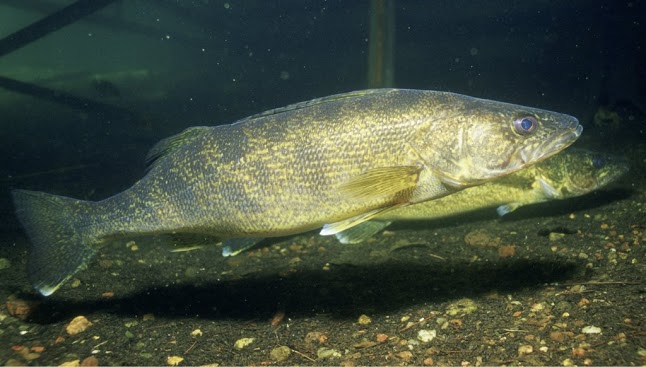
Many of the state’s Great Lakes waters are world-famous for walleye. Photo: U.S. Fish and Wildlife Service
By Edith Zhou
The Department of Natural Resources (DNR) is in its final sampling year of a tag-and-recapture study of the walleye population in the inland waterways of northern Michigan.
It’s part of ongoing research about the popular species by the Fisheries Division.
“The studies have provided data on the exploitation rate of the population, walleye growth rates and the movements between waters,” said Edward Baker, manager of the Marquette Fisheries Research Station.
Many of the state’s Great Lakes waters are world-famous for walleye.
According to the DNR, the Lake Erie-Detroit River-Lake St. Clair-St. Clair River system is the most outstanding. Inland rivers such as the Tittabawassee and Muskegon are not far behind, especially early in the season.
Tim Cwalinski, a DNR fisheries management biologist, said the researchers need help from anglers to move the study forward.
“This is an opportunity to continue learning key information regarding walleye populations in the waterway, and we rely on anglers to assist us with this project,” Cwalinski said.
Anglers who catch tagged walleye are asked to provide the tag information online to the DNR.
The research center’s annual report said its staff have been characterizing and estimating spawning runs throughout the Upper Peninsula to provide baseline information and identify factors that influence the spawning potential of the rivers.
“The results of the study are important for deciding when, where and how many walleye to stock,” Baker said.
Recent survey locations include the Rapid, Whitefish, Ford and Manistique rivers.
The department stocked more than 10,000,000 walleye statewide in 2012 and is going to stock a similar number this year.
Elsewhere, the agency is studying walleye populations in Lake Erie and Saginaw Bay.
Since walleye are stocked in many of Michigan’s waters, it’s important for fisheries managers to measure the contribution of stocked fish to walleye populations, according to the research center report.
In many waters, some stocked walleye are treated with oxytetracycline, an antibiotic which binds to bones and other calcified structures. The treated fish can be identified by ultraviolet light.
In 2012, DNR analyzed 531 antibiotic walleye samples from 11 lakes and 185 samples from rearing ponds.
“The research is important for determining survival rates of stocked fish and also the relative contribution of stocked and wild fish to the whole population,” Baker said.
Baker said data from the studies will help the department better regulate recreational fishing and stocking plans.
Harold, I watched them treat Walleye fry with this stuff. The biologists wore masked while doing it. Anyway the chemical gets in the walleye bones so later the can shine a black light on the fish bones if it glows it’s a stocked fish.
Al: The “tag and recapture” study mentioned in the article seems to refer to actual tags which can be reported by fishermen. If you check out the link, the tags are usually metal or plastic and they have an identification number.
The article also does state that some walleye are being “treated” by oxy. Whether that’s used as merely an additional marker is immaterial–they’re still being treated with the broad spectrum anti-biotic.
If you have additional information, please share, but the concern about overuse of antibiotics is still valid.
Harold needs to reread the statement about “oxy”. It is being used as a tag not a treatment. All antibiotics have “elimination dates where the liver/kidney complex eliminates the “free” drug from the blood. The tetracycline family has the ability to be “captured by young cells in the bone and teeth.After stored it is not in the meat unless continuously fed,as in other livestock.
It’s more than a bit disconcerting to hear that the DNR is treating Walleye with Oxytetracycline and then releasing those fish into the environment. How many fish are being treated with this broad-spectrum antibiotic? Millions?
Widespread use of antibiotics (many would say “overuse”!) contributes to the development of bacteria which are resistant to antibiotics. What may provide short-term benefits could turn out to be a long-term disaster. What type of public health review goes into these DNR experiments?
Please find: Ecology,Management, and Staus of Walleye, Sauger and Yellow Perch in Michigan MDNR. U of M. This is a very good study, I would like to apply the principles of this study to all our lakes, in cluding Lake Michigan and connecting waters. But I guess that’s the problem, I actually want to do it. I’m not against studies, I’m against nothing but studies that go nowhere.